Clocks don’t get nearly the attention today that wristwatches do. I get it: they take up a lot of space and you can’t wear them.
Nonetheless, there are clocks in this world that deserve to be talked about, written about, bought, and enjoyed. And this goes double for any and all of the unique timepieces by independent horologist Miki Eleta.
Eleta, a self-taught clockmaker born in Višegrad, Bosnia and Herzegovina, has lived in Switzerland since 1973 and been a member of the AHCI since 2008, showcasing his incredible kinetic sculptures alongside thirty-odd other independent artisans of varying nationality.
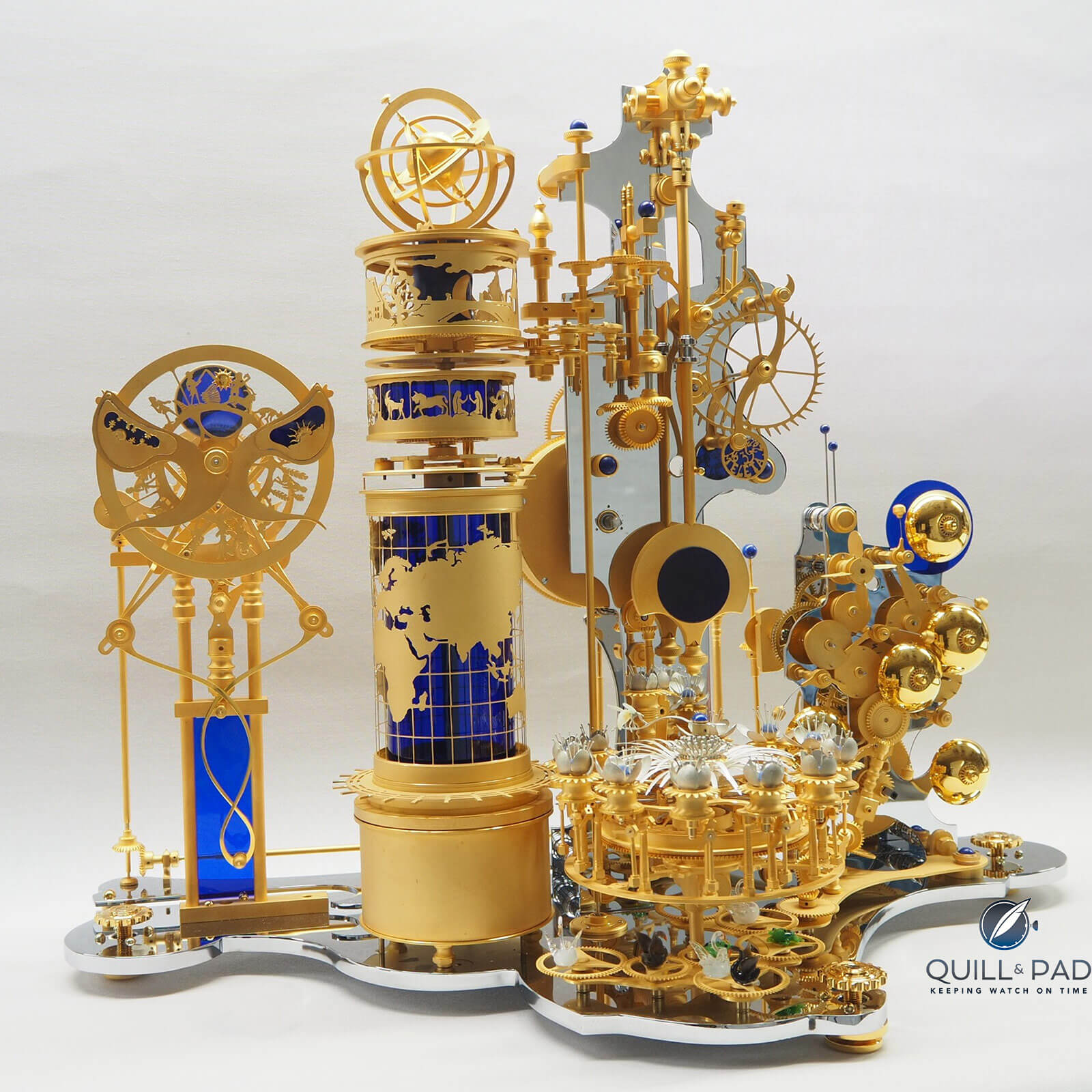
Miki Eleta Natuhrzeit
I had the pleasure of seeing Eleta’s latest masterpiece, Natuhrzeit, at Baselworld 2019 and have not been able to get it out of my mind since.
“Natuhrzeit”: clever word play
I love Eleta’s dry sense of humor when it comes to both his work and naming his creations. Eleta’s BY21Dez12ME clock of 2016 had a clever name – though less decipherable at first glance than his latest clock, Natuhrzeit, the sense of which is likely to be understood better for German speakers.
Natuhrzeit is a compound German word that you will not find in any dictionary. Natur (“nature”) and the non-existent Natuhr, which includes the German word for clock or watch, uhr, sound very similar in pronunciation. Zeit is the German word for “time,” and the compound word Uhrzeit refers to the time as shown on a clock or watch (as opposed to the general calendar day or the abstract meaning of time). Yes, German can be complicated.
So the full meaning and word play in the word Natuhrzeit cannot be conveyed with one English word. It might be best translated as “time for nature,” while also meaning “clock-shown time for nature.” Make sense? No? Not nearly as poetic in English, I’m afraid. But please take my word for it: the name is very clever to a German speaker.
And while all of this is interesting, it still doesn’t tell you what the clock does.
Or does it?
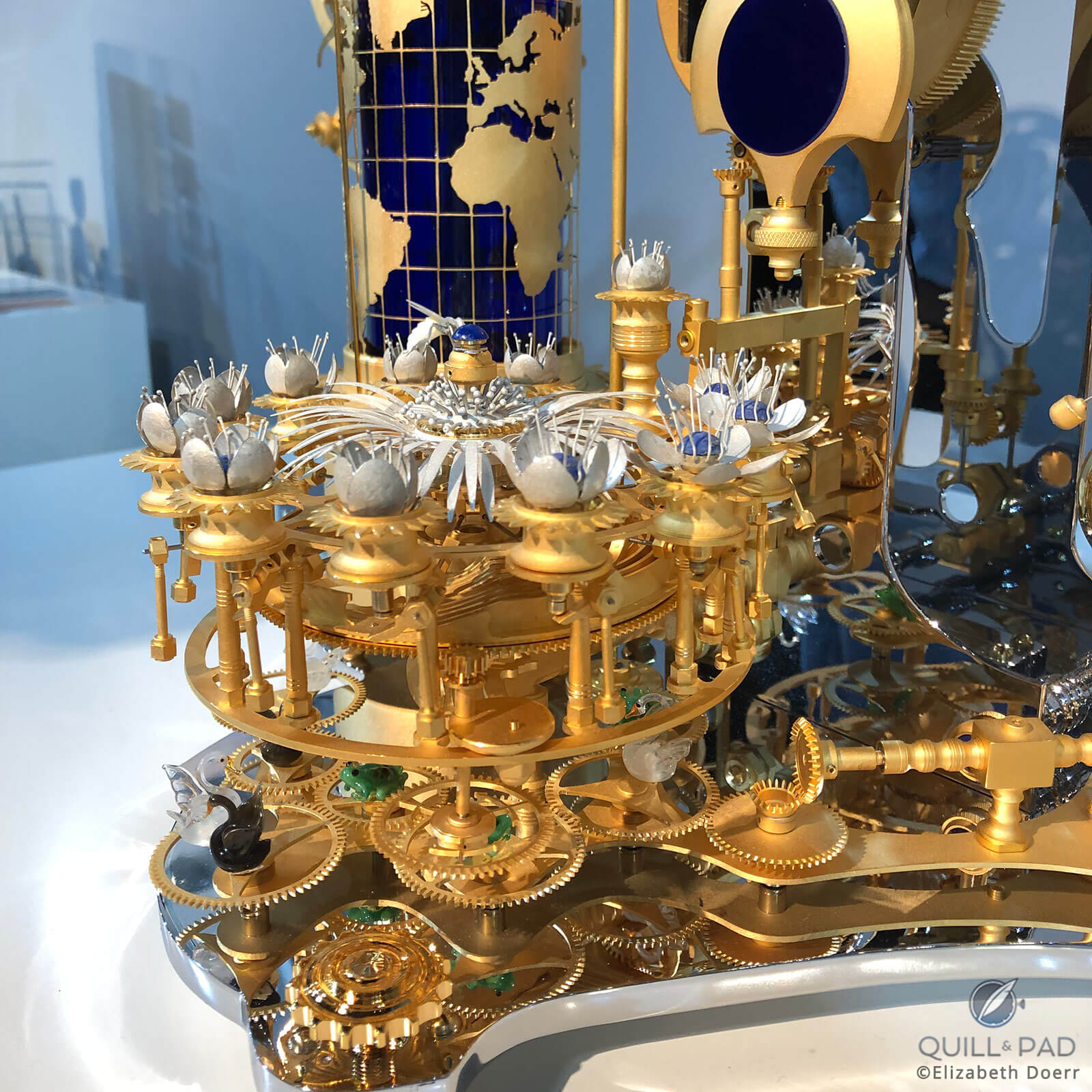
The actual clock portion of Miki Eleta’s Natuhrzeit
Miki Eleta’s Natuhrzeit
“Es ist einfach ein Stück der Natur,” Eleta explains. “It’s simply a piece of nature.”
“What you have here is like time that you experience somewhere in a forest without a telephone or radio: it’s sunrise, sunset, and other phenomena . . .” In other words, it’s the subjective perception of time passing.
The clock doesn’t show you the time in words, letters, or numerals: you must observe closely and interpret its various motion cycles to get a sense of the current time. This is something Eleta says he took right from nature.
But that doesn’t mean there isn’t anything horologically happening. Let’s take the individual elements one by one, going from left to right, to find out exactly what.
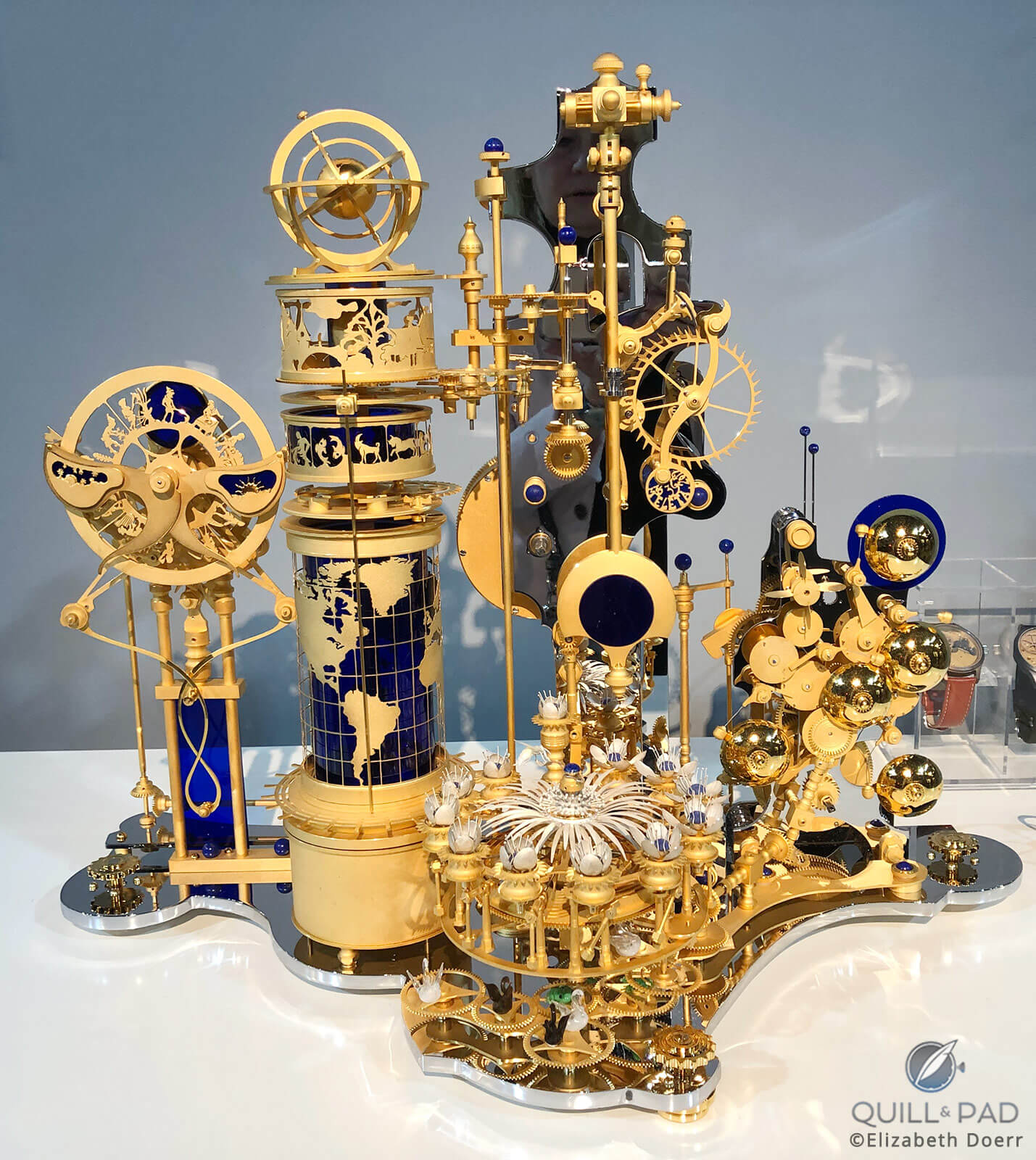
Miki Eleta Natuhrzeit at Baselworld 2019
The first column on the far left depicts sunrise (east) and sunset (west) as well as the changing length of the day during the year: the larger the surface between the “wings” at top become, the longer the daylight is. This is also shown in the figure eight-shaped symbol beneath the wings at the bottom of that sculpture: the longer the days are, the smaller the lower half of the figure eight appears.
If both halves of the eight are symmetrical, day and night are the same length; likewise, if the upper half is smaller, then the day is shorter. At its smallest point, the upper half symbolizes winter solstice; and at its smallest point, the lower half symbolizes summer solstice.
Back at the top of that kinetic sculpture we find another function depicting the month hidden among the many moving parts. Look closely at the blue glass circle and the gold figures in front of it: each one of those figures represents a different month by showing agricultural tasks typical of that month in the northern hemisphere.
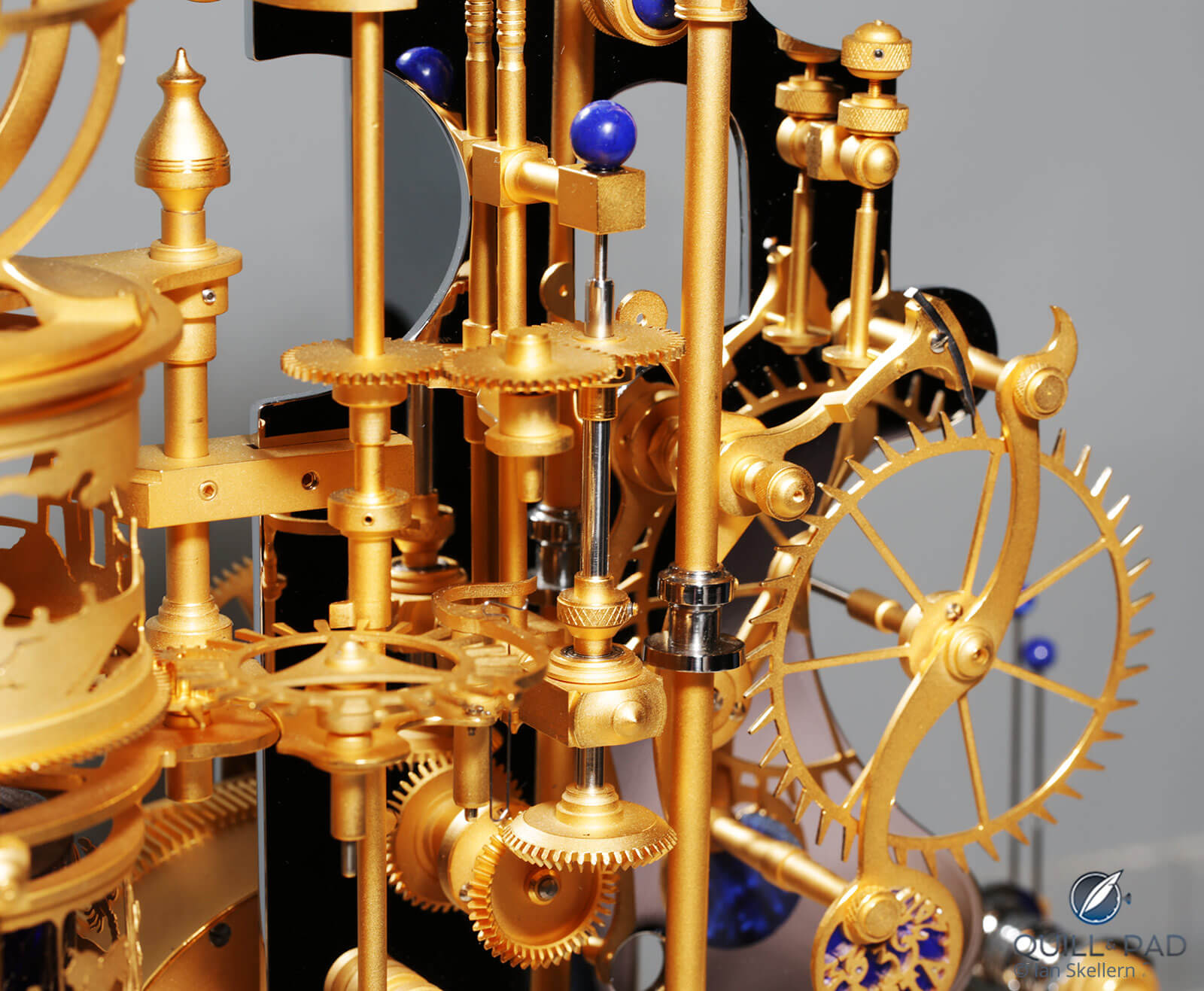
The Eleta Escapement powers Miki Eleta’s Natuhrzeit
“These depictions are typical for the work we do in nature here; for example, one would cut trees in March,” he explained, pointing to the March figurine. “In the next month we might sow seeds.”
A golden depiction of the sun is seen on the blue glass behind the month circle; this sun revolves around the blue circle every 24 hours, pulling the month display with it every time a new day begins.
Moving to the main column now, which Eleta calls the Zeitsäule, the “time column,” the first display as seen from the bottom is a depiction of world time. This display makes one full revolution every 24 hours, jumping to the next day at midnight and taking the zodiac display above it right along with it.
Above that is a cylindrical moon phase so accurate that it only needs to be corrected by one full day every 128 years.
At the very top is an armillary sphere, which may also be removed. It can be operated by hand to provide the current positioning of the heavens. “It’s been said, one needed the armillary in the fifteenth, sixteenth centuries to demonstrate the cosmic order and how the stars and sun move . . . here you can see pretty much everything.”
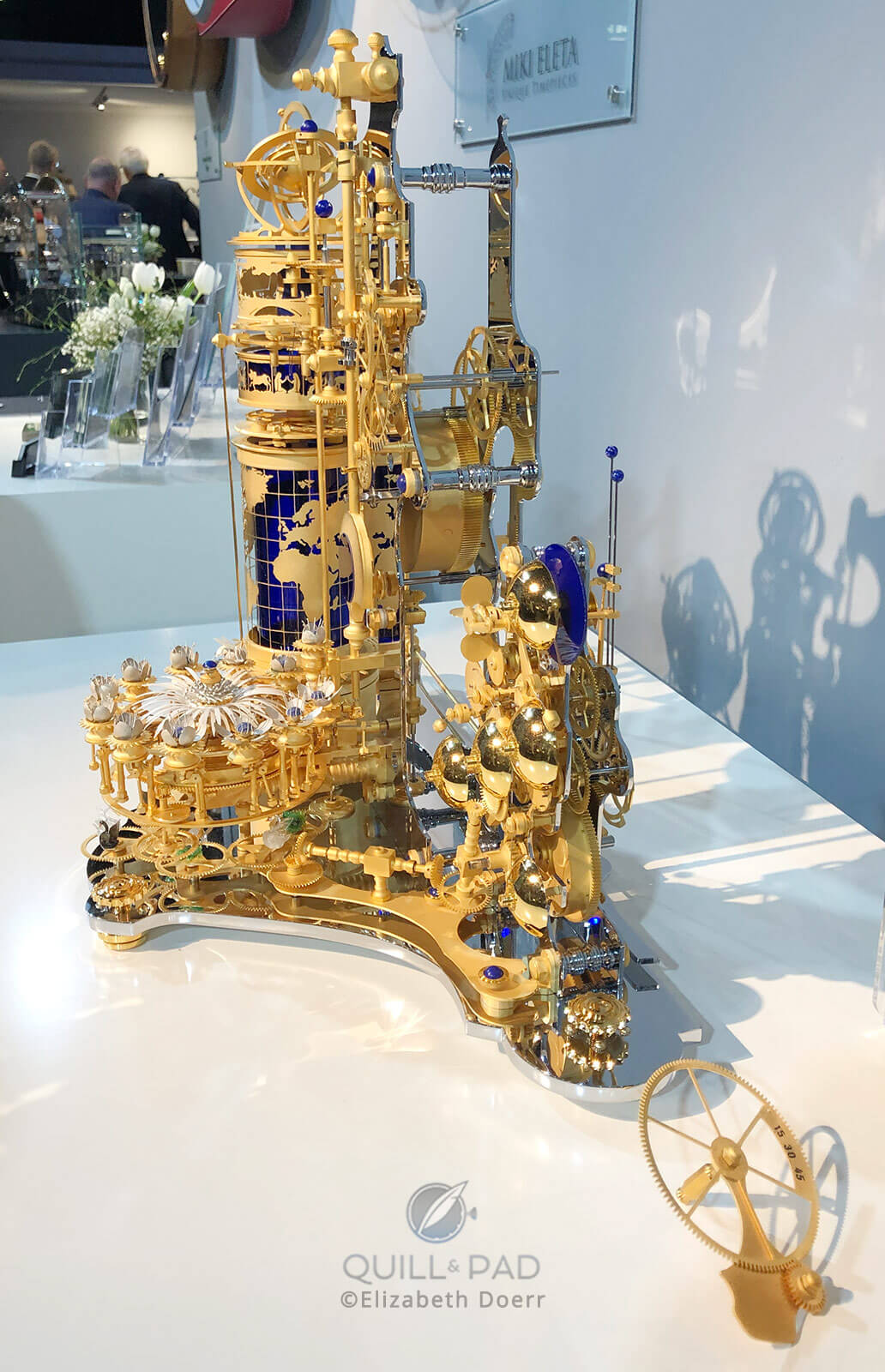
A side view of Miki Eleta’s incredible Natuhrzeit
Miki Eleta Natuhrzeit: flowers, flowers, and more flowers
However, for me it’s the exquisite flower clock to the right of the time column that provides the big show: it’s breathtakingly delightful.
This is not the first time Eleta has used this flower imagery in one of his clocks; just check out his Flower Clock. The clockwork is driven by the Eleta Escapement.
The hours are shown by 12 large, five-petal flowers in lapis lazuli and gold. Around 15 minutes before the hour, the flower opens petal by petal until it reaches the full hour. After the twelfth flower has opened (midnight), all immediately snap closed at the same time.
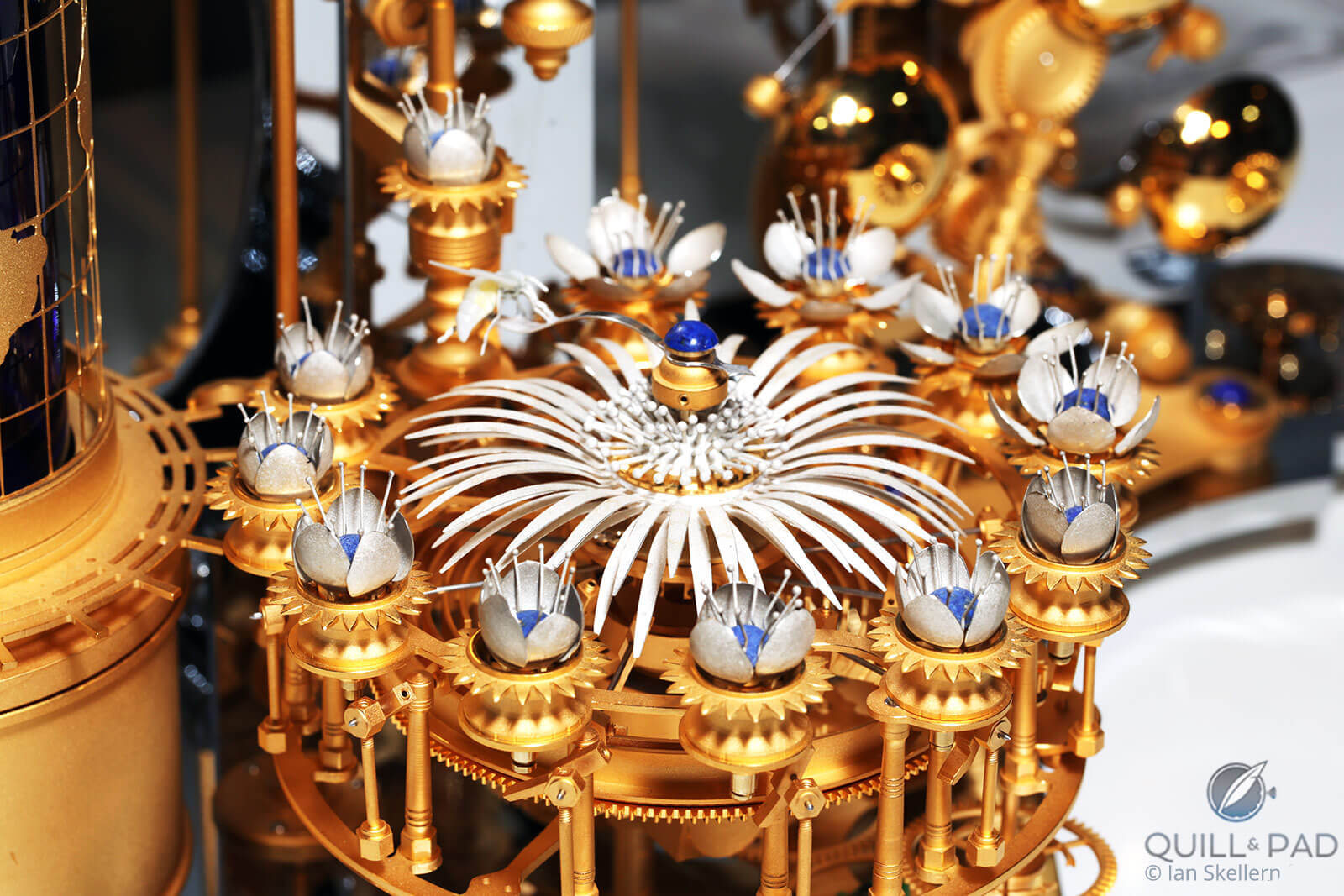
The time-telling flower clock of Miki Eleta’s Natuhrzeit
The 12 flowers form a circle around an Alpine aster with 60 petals, each representing one minute. Above the aster circles a bee pollinating the flowers. By positioning itself above one of the 60 aster petals, the bee displays the current minute.
Eleta demonstrated the motion of this clock to me by using his fingers to speed it up. “This is a bee, and the bee pollinates the flower. And the honey drips out down there. No, I’m joking. It doesn’t drip . . .” I told you he had a sense of humor.
And that’s not all: one of the most delightful parts of Eleta’s Natuhrzeit is its musical show. Once an hour, chiming gongs play a melody for approximately 20 seconds. And the melodies that play are always different: Eleta told me that they will be different for around 300 years!
“It changes constantly, going from one base melody to the next and so on. Only in about 300 years will it start to repeat. I dislike repetition,” Eleta reported, a fact highlighted by his dislike of making the same clock twice.
While the music plays, the different-colored glass animals positioned on top of the gears at the bottom of the flower clock dance along. Just exquisite.
Natuhrzeit required ten months to develop, make, assemble, and regulate. Eleta made each and every one of the components himself with the exception of the glass animals.
And it’s a unique piece. “I protect my clients who want their unique pieces. They spend a lot of money for the piece. But finding my next idea is never a problem; I have thousands of ideas, thousands. And the next one will be the funniest.”
For more information please visit www.mikieleta.ch/timepieces/natuhrzeit.
Quick Facts Miki Eleta Natuhrzeit
Materials: sandblasted, gold-plated or chrome-plated brass and steel, aluminum base, glass, lapis lazuli, mother-of-pearl, silver
Movement: manual with eight-day power reserve, Eleta escapement
Functions: jumping hours, minutes; month, moon phase, 24-hour display, world time, zodiac, sunrise, sunset, length of day, armillary for sky chart, music automaton
Limitation: one unique piece
Price: upon request
You may also enjoy:
Inspired Interstellar Exploration: Miki Eleta BY 21Dez12ME Starship Clock
Miki Eleta’s Timeburner: A Salute To Noise, Grease, Chrome, And A Special BMW Motorbike
Eric Freitas: Illustrator Turned Clockmaker Creates Mechanical Fantasies
Leave a Reply
Want to join the discussion?Feel free to contribute!





















































Automatons, … are simply fantastic. Thank you Elizabeth. Alles dudelt, dreht und bewegt sich.
There is a must see Film about independent watchmaking … it connects to your article. And you can see funny Miki Eleta in many snippets there. A world full of freeks.
The Single Men – Masters of the Incredible and the Beautiful. A Film by Philip Selkirk. 2015.
https://youtu.be/thAKJnp0ntU
Listen to Miki Eleta: “the actual process is what is beautiful. It is priceless, one cannot buy. It is pleasure … it is wonderful.”
Auf Wiedersehen, Thomas.
Happy you enjoyed the film, Thomas! Thanks. Best, Philip Selkirk http://www.selkirk-pictures.com